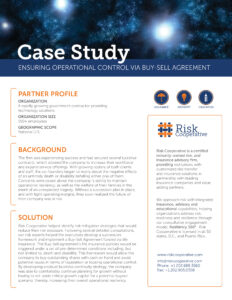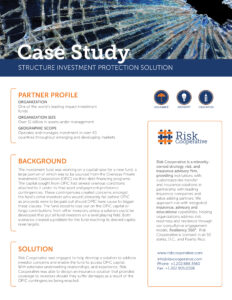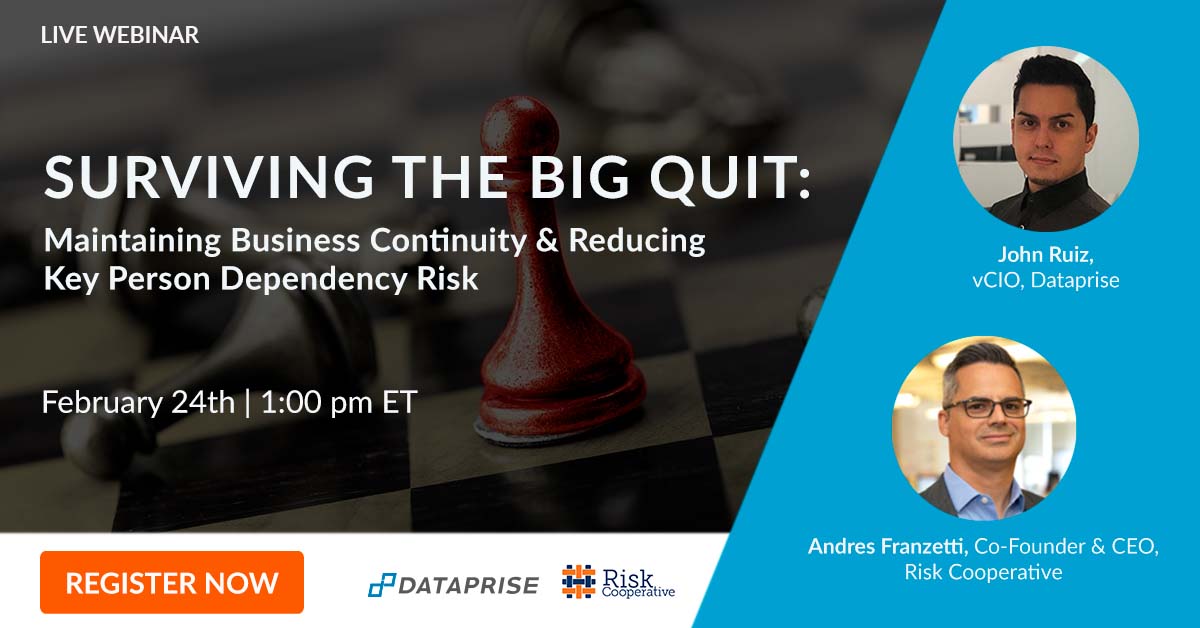Insurance Solutions
Executive and Financial
Risk Cooperative works with organizations and management teams to provide robust solutions to address the evolving regulatory and business environment. Our team of risk specialists work closely with our clients to develop a risk management and mitigation plan identifying key exposures and providing solutions to reduce or eliminate risks.
Risk Solutions
Kidnap, Ransom and Extortion Coverage
Risk Cooperative works with organizations around the globe to develop customized kidnap, ransom and extortion (KRE) policies. These policies are designed to protect employees and executive teams as they conduct business around the globe. Key coverage component includes:
- Kidnap
- Extortion
- Detention
- Personal accident (as the result of an insured event)
- Products extortion
- Hijack
- Loss of earnings
- Repatriation
Directors and Officers Liability
Also known as D&O, this coverage protects the company and personal assets of corporate officers against lawsuits related to the management of the organization.
Employment Practices Liability
EPLI protects companies against employment-related claims of wrongful termination, discrimination and harassment.
Fiduciary Liability
This coverage provides protection for the company against claims of mismanagement of the organizations employee benefits plans.
Crime
Protects against employee theft and misappropriation of company funds or assets.
ERISA Fidelity Bond Coverage
Required by law, this coverage protects the participants in an employee benefits plan against losses due to fraud or theft.
Workplace Violence
Helps organizations offset the costs of recovering from acts of workplace violence and active shooter incidents.
Resource Library
Key Person Dependency Risk or KPDR is the risk that occurs when an organization relies on a few individuals for continued business operations due to their proven knowledge or skill. These individuals may be in leadership positions, but they could just as easily serve in any department, such as IT or HR.
Workforce Turnover Exacerbates Existing KPDR Vulnerabilities
When organizations don’t properly manage their KPDR, their business continuity plans are at risk from workforce turnover. In 2021, more than 47 million employees voluntarily left their jobs for a variety of reasons, including improved work/life balance, company culture, and compensation.
“The Great Resignation is really industry agnostic,” says Andres Franzetti, “The pandemic and the last couple of years has really forced folks to reevaluate both what they’re doing personally as well as work, and the type of environment they want to work in.”
The pre-pandemic talent gap in industries like I.T. and cybersecurity has exacerbated the issue. Now, surviving the Big Quit is not only about evaluating where you have key people in your organization, but is also tied to a larger recruitment and retention strategy, especially where competition for talent is most acute.
Redundancy and Knowledge Transfer Help Mitigate KPDR
Collecting and protecting critical knowledge – information that’s specific to your organization but may not be documented – is the first step toward mitigating your KPDR. Software can assist in developing a knowledgebase that documents Standard Operating Procedures (SOPs) and other important information for greater business continuity. “If a key person were to leave tomorrow, what does the next person need to hit the ground running?” asks J.P. Ruiz, “That’s the mentality an organization has to have when deciding what to document.”
“Additionally,” says Andres “it’s about building up redundancies and succession planning.” The definition of “key person” has evolved from primarily leadership roles after organizations were caught off-guard when large numbers of employees responsible for the day-to-day running of the organization resigned and exposed KPDR vulnerabilities. Using a broader lens to identify key persons means taking stock of the core business capabilities and those who fulfill them, which may include vendors or third parties.
Beyond just documenting critical knowledge, to build resiliency firms must develop and implement knowledge transfer plans that include cross-training and tailored, multi-skill career paths for employees. Unhealthy company culture has been a key drivers of the Great Resignation; leadership can work to change their company culture by showcasing key persons playing a part in educating their coworkers, rather than withholding information to protect their key person status. Cross-trained employees enhance the organization’s ability to weather change, and become pillars of the organization themselves through participating in a new, more inclusive company culture.
Addressing KPDR Reduces Related Risks, Like Insider Threats
Insider threats are another facet of KPDR, which involves risks that originate within the organization and intentionally (or unintentionally) cause harm to the business – from disgruntled employees taking proprietary information to mistakenly clicking on a phishing email that exposes network vulnerabilities. CISA has some effective tools for evaluating insider risk while software can help track role-based access and standardize the process to reduce risk. Additionally, the cooperation of HR and IT can be a winning combination to adequately control onboarding offboarding access to mitigate insider risk at those junctures.
As cyber insurance premiums rise in response to increases in the frequency and costs of cyber attacks, carriers are requiring these kinds of additional controls for coverage eligibility. Companies will find that having detailed incident response plans will help keep insurance costs down for not only cyber, but also liability, employee liability and other types of business coverages.
Outsourcing certain business functions, such as accounting or IT, is one way to free up internal resources while adding skills and redundancy. Traditional key person insurance helps transfer the financial risk of losing a key person and often covers high-level executives. However, with the expanded definition of “key persons,” so must key person coverage evolve to include critical business functions. Cyber policies often contain integrated resources to mitigate risk while insulating companies from the financial losses and augment capabilities for response.
Conclusion
In our current risk landscape, KPDR is a real threat to firms of all sizes and across industries and adequately identifying and addressing key person dependency risk is another way organizations can build operational resilience in the face of complex risks.
VIEW THE WEBINAR RECORDING:
Maintaining Business Continuity & Reducing Key Person Dependency Risk
Have questions? Send us a message.
There is something about Wednesdays in January this year.
On January 6, the nation experienced an insurrection. A week later on Wednesday, January 12, Congress voted to approve the articles of impeachment. On Wednesday, January 20th, the U.S. witnessed an inauguration. Finally, on Wednesday, January 27, Wall Street felt the impact of coordinated retail investors.
The events unfolding in the wake of the GameStop drama involving “David” retail investors and “Goliath” institutional investors (i.e., hedge funds) will be immortalized in investor lore for generations to come.
While short selling is a tool used by retail investors and hedge funds alike, the latter have enjoyed the upper hand in maximizing potential revenue windfalls realized from the successful execution of this strategy. How do hedge funds accomplish this? Robinhood, the commission-free trading platform at the center of the controversy, and a handful of other online brokerages employ a strategy called payment to order flow. Trades placed by retail investors on the platform are sold to certain hedge funds that execute the trade and gain money from the spread, or the difference between the price to buy and sell trade orders.
More importantly, access to trading data by hedge funds is key in successfully employing strategies such as a short sale, an instrument yielding immense power in the stock market allowing investors to profit on the declining stock of a company. In context to the broader market of equities trading, according to S3 Partners, short sellers typically have a combined $900 billion to $1.3 trillion in short bets out on the market, equating to approximately 2-3% of total U.S. stock market capitalization.
While hedge funds are privy to information not available to retail investors, the great equalizer for retail investors was discovered by utilizing the power of social media. This power was fueled by the pandemic, creating a “perfect storm” for retail investors whereby the majority of Americans were stuck at home in 2020 with more time to learn about the market and experiment.
As the U.S. personal savings rate rocketed to a record 32.2% in April 2020, the result was more disposable income directed towards pursuits such as retail investing. Armed with little more than a popular Reddit group and a savvy stock picker who used the nom de guerre “Roaring Kitty,” the GameStop rally was soon underway. This, and the rapid development of the story on Twitter, including a number of popular retail investors, mounted to nothing short of a financial coup.
Hedge funds like Melvin Capital Management lost billions and were forced to close their short position as the growing army of retail investors began executing a short squeeze aimed at dismantling the short sale efforts intended to profit from the demise of GameStop stock.
The short squeeze onslaught came to a climax on Wednesday, January 27, when the stock rose by 135%, reaching a record $347.51. Ordinarily, hyper volatile markets on Wall Street result in privatizing gains and socializing losses, usually in the favor of institutional players. In this instance, the tables were turned, and gains were socialized while losses were institutionalized.
In a controversial series of events, Robinhood restricted trading of GameStop and other selected stocks by retail investors on this chaotic Wednesday while allowing hedge funds to continue to trade uninterrupted.
A letter written by Congressman Paul A. Gossar (R) uncovered the fact that hedge fund Melvin Capital Management provides Robinhood with approximately 40% of its revenue, so it is no surprise that Robinhood elected to allow hedge funds like Melvin to continue trading activities.
Hedge funds should not be entirely to blame, it is the nature of the system that has created this seemingly unlevel playing field. Access to information and the ability to trade without interruption were just a few hedge fund advantages exposed on that pivotal Wednesday.
Hedge funds have other privileges, such as the luxury of accessing news outlets to offer their views on stocks and potentially influence prices, but the recent short squeeze marked an unprecedented and creative way to counteract hedge funds by utilizing social media as a megaphone to rally like-minded retail investors. Reddit has become the veritable Moody’s for retail investors. With all the market manipulation occurring, is Adam Smith’s panacea of an invisible hand determining market outcomes now obsolete?
More importantly, what circuit breakers or rules on market conduct will be implemented to ensure a level playing field for all market participants and put limits on the insidious practice of taking up such deep and distortive short positions? In GameStop’s case, the short sellers were at 140% of the company’s market value, which in itself could have a self-fulfilling effect hurting the firm and its market value at a time when GameStop’s more than 5,000 stores and 53,000 employees labor with the effect of pandemic closures and restrictions.
Risk Management, Not Insurance
Human involvement in the financial outcome of a transaction takes on many forms in the ongoing “trading arms race.” High-frequency traders utilize technology to gain nanoseconds on their trades via next generation cables, called hollow-core fiber. For many years, trading firms have practiced collocation, where they place their trading computers within the same data centers as servers used by the stock exchange on which they trade to gain even a millisecond advantage over other traders.
With half of daily trading volume performed by advanced computing algorithms, the proverbial invisible hand determining market outcomes is forced in unnatural directions by competing manmade activities that can cause market volatility. The 2012 demise of the high-frequency trading firm, Knight Capital, offers a cautionary tale about the effect of speed and so-called “rogue algorithms” in financial markets.
Several important risk management practices and pieces of legislation have been implemented to counteract this market volatility, the most famous being the advent of the circuit breaker instituted after the Black Monday crash of 1987.
The circuit breaker is triggered if the Dow Jones or Nasdaq trading volume falls by 7%, 13% or 20% of the closing price from the previous day, causing trading to cease for 15 minutes to discourage panic-selling and instill a sense of calm in the market. Four circuit breakers were famously triggered at the beginning of the pandemic in 2020 on March 9, 12, 16 and 18.
By preventing another stock market crash like Black Monday, circuit breakers also help lessen the burden on taxpayers who underwrite government stimulus checks to businesses and individuals in the aftermath of a fiscal crisis. Better to have a risk management tool, like a circuit breaker, instituted instead of relying strictly on insurance in the form of financial payouts to the masses.
The question with the GameStop case, as well as other stocks where the short sellers’ positions are now visible, is what guardrails will be put in place?
The Game Stops Here
As the GameStop story continues to unfold for the foreseeable future. Expect the Securities and Exchange Commission (SEC) to implement new risk management measures to lessen the impact of future retail investor vs. hedge fund conflicts arising from insidious short positions.
Here are some predictions of the actions the SEC may consider:
1 | Cap Short Selling
There was a queue of investors waiting to place short sell positions on GameStop. There should be limits on the absolute amount investors can short a stock, this would prevent massive losses experienced by firms such as Melvin Capital.
2 | Restrict Margin Allocation Amounts
Retail brokerages like Robinhood should implement stricter guidelines on margin accounts, or accounts where investors can use leverage to buy stocks. For example, capping the maximum margin account limits to an even lower level, like 20%, of the value of securities in the account. While it will be hard for the SEC to police retail investors utilizing social media channels to amplify their stock buying power, restricting margin limits can help separate the “real money” from the “margin leverage” being used so that a more accurate picture of the underlying value of a stock can be realized. Separately, restricting margin limits can help prevent novice retail investors from suffering major financial setbacks or worse, such as the untimely passing of a young investor who took his own life.
3 | Stricter Margin Requirement Underwriting
It seems easier to get a credit card than it does to purchase securities on margin, with the latter being more disastrous should a financial crisis occur. Obtaining a margin account should have stricter underwriting requirements, factors such as credit score should play a role. The goal is not to deprive investors of a margin account, but to regulate the amount of margin available to each specific investor. Some investors may not qualify for the maximum 20% margin limit offered by a brokerage, for example, but they can apply for higher margin limits as certain factors change like increases to their credit score.
4 | Revisiting Zero Commission Trading
Robinhood revolutionized the zero commission trade, which spread to other major retail brokerages. It may be time to revisit Robinhood’s model so that hedge funds are not able to account for such a large percentage of a brokerage’s revenue.
Companies and the people they employ are what creates value in our modern economy. The market manipulation of short selling and betting against these companies is a distortion, something that backfired once retail investors banded together in large numbers. Short selling should be regulated more closely to prevent another GameStop from occurring, while also giving a company on the “proverbial ropes” a fighting chance to recover.
One thing is for certain, the influence of Main Street is now a force to be reckoned with among the power brokers on Wall Street.




